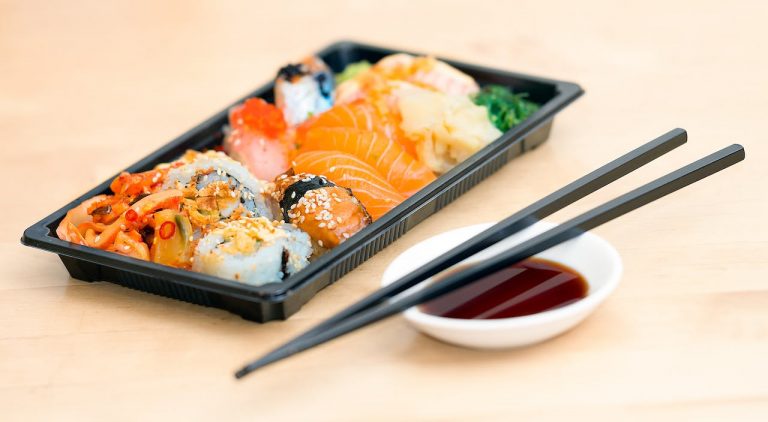Sushi, a traditional Japanese dish that has gained immense popularity worldwide, is renowned for its unique combination of flavors and aesthetics. This culinary art form delicately balances rice, fish, and other ingredients to appeal to the palate and the eye. However, as health-conscious foodies know, the enjoyment of sushi comes with a responsibility: understanding how to store it properly and recognizing signs of spoilage.
The key to relishing sushi lies in its freshness. Unlike many other cuisines, sushi’s primary ingredient, often raw fish, demands careful handling and storage. This necessity arises from the potential health risks of improperly stored or spoiled sushi. Therefore, sushi lovers must know how long sushi can be safely consumed, the best storage practices, and the signs indicating it’s time to discard it.
This comprehensive guide will explore the various aspects of sushi storage and spoilage. We’ll delve into how long sushi is good for, both at room temperature and in the fridge, and provide you with essential tips to identify and handle sushi that may no longer be safe to eat. Whether you’re a sushi connoisseur or a casual fan, this guide will equip you with the knowledge to enjoy sushi safely and with peace of mind.
Let’s dive into the fascinating world of sushi preservation, starting with understanding how long sushi remains suitable for consumption.
How Long Is Sushi Good For?
Understanding its shelf life is crucial in the quest to enjoy sushi safely. Considering various factors and types, let’s explore how long sushi is good for.
Factors Affecting Sushi’s Shelf Life
- Type of Sushi: Sushi comes in various forms, from Nigiri (fish on rice) to Sashimi (just the fish), and each has a different shelf life.
- Ingredients Used: The freshness of ingredients, especially seafood, plays a crucial role. Raw fish spoils faster than cooked or vegetable-only sushi.
- Preparation Method: The way sushi is prepared, including the hygiene practices followed, significantly impacts its longevity.
- Storage Temperature: Sushi kept at room temperature will spoil faster than refrigerated sushi.
General Guidelines for Different Types of Sushi
- Nigiri and Sashimi: Ideally consumed immediately, but can be refrigerated for up to 24 hours.
- Maki Rolls (with cooked ingredients): These can last a bit longer, up to 48 hours in the fridge, given the cooked components.
- Vegetarian/Vegan Sushi: Since they lack raw fish, they can be good for about 2 days when refrigerated.
How Long Does Sushi Last in the Fridge?
Understanding the shelf life of sushi in the refrigerator is key to ensuring its freshness and safety. The longevity varies depending on the type of sushi, ranging from raw fish to vegetarian options.
Raw Fish Sushi
Sushi featuring raw fish, such as sashimi or nigiri, is best enjoyed for its freshness and delicate flavors. In the fridge, this type of sushi typically remains safe to eat for 1 to 2 days.
The key to its longevity lies in immediate refrigeration at a consistent temperature of 40°F (4°C) or lower. Raw fish is highly perishable due to its susceptibility to bacteria growth and degradation, so it’s crucial to consume it within this timeframe. Beyond two days, the quality and safety of the sushi may be compromised, leading to potential health risks.
Cooked or Smoked Fish Sushi
Sushi made with cooked or smoked fish, such as certain types of maki rolls or smoked salmon nigiri, has a slightly longer shelf life in the fridge. Properly refrigerated, it can last up to 3 days. The cooking or smoking process extends the sushi’s shelf life by killing most of the bacteria present in raw fish.
However, it’s still important to store it in an airtight container to prevent cross-contamination and maintain its quality. While the risk of bacterial growth is lower, it’s still present, so adhering to the 3-day guideline is recommended for safety and enjoyment.
Vegetarian Sushi
Vegetarian sushi, which typically includes ingredients like avocado, cucumber, and pickled radish, can last up to 5 days in the fridge. This extended shelf life is due to the absence of highly perishable ingredients like raw fish. Sushi’s vegetable and other plant-based components are less prone to bacterial growth that can cause spoilage.
However, it’s still essential to store vegetarian sushi under the same strict conditions – in an airtight container at a temperature of 40°F (4°C) or lower. Even though it lasts longer, it’s still important to check for signs of spoilage, such as changes in smell, texture, or appearance, before consumption.
Tips for Optimal Refrigeration
To ensure your sushi retains its quality and safety while stored in the fridge, follow these tips:
Temperature Control: Keep your refrigerator at or below 40°F (4°C). This temperature slows down bacterial growth.
Air-Tight Containers: Store sushi in air-tight containers to prevent it from absorbing odors from other foods and to retain moisture.
Avoid Cross-Contamination: Store sushi separately from raw ingredients like meat to prevent cross-contamination.
Signs of Sushi Spoilage
Recognizing when sushi has gone bad is crucial for avoiding foodborne illnesses. Here are key signs to watch for:
Visual Indicators of Bad Sushi
- Discoloration: Look for any unusual changes in color, particularly in the fish, which might indicate spoilage.
- Drying Out: If the sushi rice or fish appears dry or hard, it’s a sign that the sushi is no longer fresh.
- Mold Growth: Any signs of mold, no matter how small, mean the sushi should be discarded immediately.
Changes in Smell and Texture
- Unpleasant Odor: Fresh sushi should have a mild, ocean-like smell. A strong, sour, or unpleasant odor is a clear sign of spoilage.
- Slimy Texture: Fish or other ingredients in sushi should never feel slimy. This texture suggests bacterial growth.
Health Implications of Consuming Spoiled Sushi
Eating sushi that has spoiled can lead to food poisoning. Symptoms can range from mild discomfort to severe illness, depending on the type of bacteria or toxins present. Common symptoms include nausea, vomiting, diarrhea, and abdominal pain.
It’s especially important for vulnerable populations, such as pregnant women, young children, the elderly, and individuals with compromised immune systems, to avoid eating spoiled sushi.
Risks of Eating Spoiled Sushi
Eating spoiled sushi can pose significant health risks, ranging from mild discomfort to severe foodborne illnesses. Understanding these risks is essential for anyone who enjoys sushi, especially those more susceptible to foodborne illnesses.
Food Poisoning Symptoms
- Nausea and Vomiting: Often the first signs of food poisoning, they can appear within hours of consuming spoiled sushi.
- Diarrhea: Frequent and sometimes severe, diarrhea is a common symptom of consuming contaminated food.
- Abdominal Pain and Cramps: These can be intense and uncomfortable, resulting from the body’s reaction to harmful bacteria.
Long-term Health Risks
In most cases, the symptoms of food poisoning from sushi are short-lived. However, in some instances, especially with certain bacteria like Vibrio vulnificus, present in raw seafood, there can be more severe and even life-threatening complications. These may include severe dehydration, prolonged digestive problems, and, in rare cases, bloodstream infections.
A study published in the Journal of Food Protection highlights the risks associated with consuming raw seafood, noting that the presence of pathogens like Salmonella and Vibrio species can lead to severe health implications. This research underscores the importance of properly handling and storing sushi to mitigate these risks.
How to Store Sushi
Proper storage of sushi is key to maintaining its freshness and preventing spoilage. Here are the best practices for storing sushi:
- Immediate Refrigeration: Sushi should be refrigerated as soon as possible after purchase or preparation.
- Air-Tight Containers: Use air-tight containers to store sushi. This helps to maintain moisture and prevent the absorption of other food odors.
- Correct Temperature: Keep your refrigerator at or below 40°F (4°C) to slow down bacterial growth.
- Separate Storage: Store sushi separately from raw foods, especially raw meats, to avoid cross-contamination.
Ideal Containers and Temperatures
When storing sushi, the choice of containers and the maintenance of the right temperature are vital to preserve its freshness and prevent spoilage.
Glass Containers: Glass is an excellent choice for storing sushi as it doesn’t absorb odors or flavors and keeps the food visible. Look for containers with airtight lids to maintain freshness and prevent any external contaminants.
BPA-Free Plastic Containers: If opting for plastic, ensure it’s BPA-free to avoid any potential chemical leaching. Plastic containers are lightweight and durable, making them convenient for storage. Again, tight-fitting lids are essential to seal in freshness and protect against odors from other foods in the fridge.
How to Handle Leftover Sushi Safely
Leftover sushi, if handled correctly, can be a delightful treat even after the initial meal. Here’s how to manage it safely:
Step-by-Step Guide to Handling and Storing Leftover Sushi
Safely handling and storing leftover sushi is crucial to extend its shelf life and ensure it remains safe to eat. Here’s a more detailed guide:
Prompt Refrigeration:
- Timing is Key: It’s essential to refrigerate sushi within two hours of serving or purchasing. This time frame is critical to prevent bacterial growth that can occur at room temperature.
- Mind the Temperature Zone: If you’re dining out, consider the time it takes to transport the sushi home. If it exceeds two hours, it’s safer to avoid keeping the leftovers.
Proper Containers for Storage:
- Shallow, Air-Tight Containers: These are ideal for storing sushi. Shallow containers help cool the sushi evenly, while an air-tight seal prevents air and moisture from getting in, which can degrade the quality of the sushi.
- Separate Components if Possible: If your sushi has sauces or toppings, consider storing them separately to maintain the texture and quality of the rice and fish.
Cooling Before Refrigeration:
- Room Temperature Cooling: If your sushi has been sitting out, especially in a warm environment, let it cool down to room temperature before placing it in the fridge. This helps to prevent condensation inside the container, which can make the rice soggy and accelerate spoilage.
- Avoid Hot Storage: Never put warm sushi directly into the fridge. This can raise the temperature inside the fridge, potentially putting other stored food at risk.
By following these steps, you can safely enjoy your leftover sushi. These practices are not just about preserving the dish, but also about ensuring that it remains a healthy and enjoyable meal for the next day.
Tips to Maximize Freshness
To maximize the freshness of leftover sushi, there are several important tips to keep in mind. First, it’s advisable to avoid freezing sushi, as this can significantly alter its texture and flavor, particularly the rice and raw fish components.
When it comes to consumption, it’s best to eat leftover sushi within 24 hours, especially if it contains raw fish, to ensure both taste and safety. Before eating any leftover sushi, always inspect and smell it to confirm that it hasn’t spoiled. These simple yet effective steps can help maintain the quality and safety of your sushi, allowing you to enjoy it just as much the next day.
Additional Considerations
When it comes to enjoying sushi, there are additional factors to consider that go beyond storage and spoilage. These include selecting the right ingredients and understanding the differences between homemade and store-bought sushi.
Choosing Fresh Ingredients
For those who love making sushi at home, selecting high-quality, fresh ingredients is paramount. Here are some tips:
- Fish: Look for fresh, sushi-grade fish with a firm texture and a clean, oceanic smell. Do not buy fish with any sour or ammonia-like odors.
- Rice: Use sushi rice, known for its stickiness and ability to hold together. Make sure it’s cooked and seasoned correctly for the best flavor and texture.
- Vegetables: Choose fresh, crisp vegetables. Their freshness not only contributes to the overall taste but also to the sushi’s shelf life.
Homemade vs. Store-Bought Sushi
- Shelf Life: Homemade sushi might have a shorter shelf life compared to some store-bought options, which may contain preservatives.
- Ingredient Quality: You have more control over the quality and freshness of ingredients when making sushi at home.
- Handling and Storage: With homemade sushi, you can ensure optimal handling and storage conditions right from the start, which can impact its longevity and safety.
Understanding these nuances can enhance your sushi experience, whether you’re dining out, ordering in, or crafting your own rolls at home.
The Bottomline
Sushi, with its delicate flavors and textures, is a culinary delight that demands careful handling and storage to maintain its quality and safety. Throughout this guide, we’ve explored how long sushi is good for, both in the fridge and at room temperature, and provided insights on recognizing spoilage signs and the risks of consuming spoiled sushi. We’ve also covered the best practices for storing and handling sushi, including ideal containers and temperatures, and provided a detailed guide for managing leftover sushi safely.
Understanding these aspects ensures that your sushi experience remains not only enjoyable but also safe. Remember, the freshest ingredients, proper storage, and prompt consumption are key to relishing this exquisite cuisine. Whether you are preparing sushi at home or enjoying it from a restaurant, these guidelines will help you make the most of your sushi experience while prioritizing health and safety.
FAQ
How long is leftover sushi good?
The shelf life of leftover sushi largely depends on its ingredients. For sushi containing raw fish, it’s recommended to eat it within 24 hours when stored in the fridge. Sushi with cooked ingredients or vegetables can last for up to 48 hours under proper refrigeration.
Is it okay to eat leftover sushi?
Eating leftover sushi is generally safe if it has been properly stored in the refrigerator and consumed within the recommended timeframe. It’s important to consider the type of sushi and its ingredients for safety. Always inspect it for any signs of spoilage, such as odor, discoloration, or texture changes, before consuming.
Do you reheat sushi?
Sushi is traditionally enjoyed at room temperature or slightly chilled. Reheating is not typically recommended, especially for sushi with raw fish, as it can degrade the quality and texture. If the sushi contains cooked ingredients like tempura or grilled eel, you can reheat it gently, but be aware that this might change its original flavor and texture.












